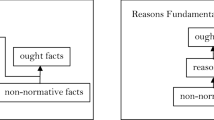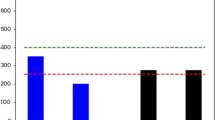Abstract
Richard Bradley’s landmark book Decision Theory with a Human Face makes seminal contributions to nearly every major area of decision theory, as well as most areas of formal epistemology and many areas of semantics. In addition to sketching Bradley’s distinctive semantics for conditional beliefs and desires, I will explain his theory of conditional desire, focusing particularly on his claim that we should not desire events, either positively or negatively, under the supposition that they will occur. I shall argue, to the contrary, that permitting non-trivial desirabilities for events whose occurrence is known or assumed is both more intuitively plausible and more theoretically fruitful than Bradley’s approach. In the course of the discussion I will contrast Bradley’s broadly evidentialist picture of decision theory with my own more orthodox causal approach.
Similar content being viewed by others
Notes
More specifically, we make sure that one proposition X is more likely than another Y under the supposition of A only if A & X is unconditionally more probable than A & Y.
I will be sloppy with use/mention. Here each potential antecedent An is a sentence that is associated with a proposition [An] ⊆ W. Also, in Bradley’s theory one can suppose arbitrary prospects, but for simplicity, I will consider only supposed propositions.
The content of a sentence is the set of all atomic prospects at which it is true.
This is not Bradley’s example. In his example the relevant proposition is I am isolated, and the assumption is that any news I receive would convince me that I am not isolated. I find this example needlessly vague owing to the difficulty in explaining what it is to be “isolated”.
Readers may convince themselves that this defines a probability over worlds in An that satisfies both Certainty and Anchoring.
For simplicity, I will confine my attention to the desirabilities of propositions. All of what I say here could be said for more general prospects.
This equation captures the idea, defended in Joyce (1999, p. 178) that all value is news value assessed from a particular epistemic perspective.
For Certainty, use the equivalence of An *→ (ω & An) and An *→ ω.
Vn*(X) = Σω un(ω)·P *n (ω | X) = Σω kn·(u(ω) · P *n (ω | X) – Jn*(⊤*)) = kn·(Jn*(X) − Jn*(⊤*)).
Both causal and evidential decision theorists can agree to this, though they will advocate different sorts of supposition. For the causalist it will be counterfactual/interventionist supposition, for the evidentialist it will be indicative/evidential supposition.
Since I am a causal decision theorist, I endorse this rule with counterfactual/interventional supposition. Were I an evidentialist, I would endorse it with indicative/evidential supposition.
I am simplifying Bradley’s notation somewhat.
The penultimate identity holds because P(An) = 1, and ultimate one holds via modus ponens.
For simplicity I am going to assume that both α and β are ranked above the initial status quo. If they were ranked below ⊤*, then their cost would be negative, i.e., one would be paid to accept their truth.
A similar argument shows that you will do the same if “<” is replaced by “>”.
References
Adams, E. (1975). The logic of conditionals. Dordrecht: Reidel.
Armendt, B. (1988). Conditional preference and causal expected utility. In W. Harper & B. Skyrms (Eds.), Causation in decision, belief change and statistics (pp. 3–24). London: Kluwer Academic Publishers.
Bennett, J. (1988). Farewell to the phlogiston theory of conditionals. Mind, 97, 509–527.
Bradley, R. (2017). Decision theory with a human face. Cambridge, UK: Cambridge University Press.
Jeffrey, R. (1983/1965). The Logic of decision, 2nd revised edition. University of Chicago Press: Chicago.
Joyce, J. M. (1999). The foundations of causal decision theory. Cambridge, UK: Cambridge University Press.
Joyce, J. M. (2010). Causal reasoning and backtracking. Philosophical Studies, 147, 139–154.
Lewis, D. K. (1976). The probability of conditionals and conditional probabilities. The Philosophical Review, 85(3), 297–315.
Pearl, J. (2000). Causality: Models, reasoning and inference. Cambridge: Cambridge University Press.
Ramsey, F. (1931). General propositions and causality. In R. B. Braithwaite (Ed.), The foundations of mathematics and other logical essays [by F. P. Ramsey]. London: London Kegan Paul.
Spirtes, P., Glymour, C., & Scheines, R. N. (2000). Causation, prediction, and search. Cambridge, Mass: MIT Press.
Weirich, P. (1980). Conditional utility and its place in decision theory. Journal of Philosophy, 77(11), 702–715.
Author information
Authors and Affiliations
Corresponding author
Additional information
Publisher's Note
Springer Nature remains neutral with regard to jurisdictional claims in published maps and institutional affiliations.
I would like to thank Jason Mckenzie Alexander, Richard Bradley, Jason Konek, Christian List, Sarah Moss, Orri Stefánsson, and Brian Weatherson for useful input on the content of this paper.
Rights and permissions
About this article
Cite this article
Joyce, J.M. Conditional desirability: comments on Richard Bradley’s decision theory with a human face. Synthese 198, 8413–8431 (2021). https://doi.org/10.1007/s11229-020-02579-2
Received:
Accepted:
Published:
Issue Date:
DOI: https://doi.org/10.1007/s11229-020-02579-2




